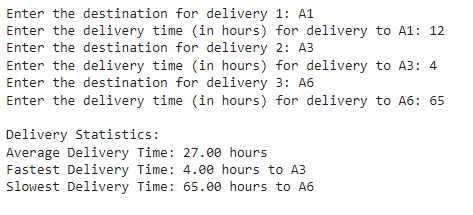$20 Bonus + 25% OFF CLAIM OFFER
Place Your Order With Us Today And Go Stress-Free
Software efficiency is a concept that has come to the mean improvement of code to achieve better performance, use the smallest amount of memory possible and be able to adjust when a larger system is implemented. Efficient code not only does things quickly but also preserves computational resources which is valuable in the current world of data. This assessment focuses on a fictional scenario involving a package delivery company's tracking system. The time complexity is measured in terms of the distance and trajectories, while space complexity is based on the number of nodes in the planning paradigm.
Code readability refers to how easy the planner code is to understand and maintain over time. The goal of the study will be to present such aspects of programming as a selection of algorithms and data structures, possible optimizations as well and ways to handle specific edge cases that have the most profound effect on the performance of the resulting code. By doing so, the overall assessment is going to emphasize the effectiveness of programming to ensure the scalability of applications.
The case study problem is centred on creating a package delivery tracking system to track and report the status of a package using tracking numbers that are input by the user. This process involves coming up with a system that requests tracking numbers, and then provides-status messages like ‘In transit’, ‘Out for Delivery’ or ‘Delivered’. Input must always be checked for conformity to the correct format for delivery data, response time must also be fast enough to improve the user-friendliness of the system while at the same time keeping the system clear and easy to understand.
As with most solutions to concrete context problems, there are possible issues resulting from increased efficiency: Larger amounts of data need to be processed as package volume rises. This may result in a slower response to the request being made, leading to other adverse impacts on a user perspective in case the search or update algorithms are slow. Furthermore, sub-optimal data structure choices lead to inefficient uses of memory as well as slow query results. These inefficiencies are important to performance since accurate information is vital in ensuring that user satisfaction and confidence in the tracking system are not compromised.
Selecting the most optimum algorithms and data structures for use at the design stage in tracking package delivery is necessary during the process. Using a hash table for account of all stored data gives the average time complexity of O(1) for its search, hence delivery status can be easily accessed. This was because lists or array data structure have worst case search time of O(n) which will going to affect the rate at which the program performs when the size of the hash table increases. Furthermore, the design handles error conditions that involve inputs that are in bad format, in order to ensure that the system remains useful even as its ability to execute the tracking request is enhanced.
In order to test the package delivery tracking system, different scenarios were utilized both for the normal use and for edge cases. A generic tracking number like “A00001D” was input to verify that the system gives the right delivery status like “In Transit” or “Delivered”. Special case scenarios were also considered, such as the inputs being in a wrong format like “A12345D” which is not the format that was expected and a tracking number which does not exist like “A00004D.” The inputs of these tests proved the system’s capability to make a quick notification to the user whenever they input the wrong data or fail to input mandatory information, this made the system more reliable and with better user interface.
Table 1 : Test Case Results
| Test Case | Input | Expected Output | Actual Output | Result |
| Valid Tracking Number | A00001D | Status: In transit | Status: In transit | Pass |
| Invalid Tracking Number | A12345D | Error: Invalid tracking number format | Error: Invalid tracking number format | Pass |
| Non-Existing Tracking Number | A00004D | Error: Tracking number not found | Error: Tracking number not found | Pass |
The tracking system was also assessed in a time space perspective where time complexity and memory were measured. The system utilizes a hash table in data storage, for an average time complexity of O(1) on record retrieval. The fact that this execution time remains constant when the queries are valid is highly efficient especially because the size of the data set keeps growing. Additionally, memory usage remains low due to the efficient nature of the dictionary structure. These characteristics are crucial for scalability, as the system can handle a large volume of tracking numbers without performance degradation. The ability to maintain rapid query responses, regardless of dataset size, makes this solution optimal for real-world applications involving extensive tracking data.
The big data assignment activities carried out in the implementation of the package delivery tracking system gave the following results, The implementation of the dictionary proved to enhance efficient data handling by enabling the system to sort through various data quickly and retrieve the status of the delivery with less effort while at the same time the user interface was designed in a friendly manner.
The final testing approved the solution’s capability to handle back both valid and invalid types of inputs and disprove the efficiency problem. In any case, possible enhancements for the future may include the fine-tuning of the data storage structure for more scalability and the use of other algorithms for monitoring the number of search requests. Also, it improves reliability when using a real-time process to handle large amounts of data in a short time because it is more efficient and beneficial for users in terms of response time in cases of high use.

Figure 1 : Customer Registration

Figure 2 : Vehicle Capacity Calculator

Figure 3 : Delivery Time Estimator

Figure 4 : Delivery Cost Calculator

Figure 5 : Delivery Route Optimizer

Figure 6 : Goods Classification Lightweight

Figure 7 : Goods Classification Mediumweight

Figure 8 : Goods Classification Heavyweight

Figure 9 : Package Delivery Tracking Status - In transit

Figure 10 : Package Delivery Tracking Status - Out for delivery

Figure 11 : Package Delivery Tracking Status – Delivered

Figure 12 : Delivery Statistics

Figure 13 : Delivery Schedule Generator

Figure 14 : Account Settings
| Advanced Wireless Network Design for NanyaNet | Machine Learning for Store Sales Projection in Supermarkets | Human Centred Systems Design |
Are you confident that you will achieve the grade? Our best Expert will help you improve your grade
Order Now